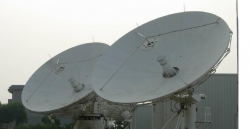If you wish to contribute or participate in the discussions about articles you are invited to contact the Editor
BeiDou Ground Segment: Difference between revisions
| Line 15: | Line 15: | ||
[[File:CompassAntenas.PNG|COMPASS Ground Segment|thumb|250px]] | [[File:CompassAntenas.PNG|COMPASS Ground Segment|thumb|250px]] | ||
The COMPASS Ground Segment consists of:<ref name=BEIDOU_MUNICH_2011/><ref>[http://www.filasinternational.eu/sidereus-project/pdf/02.pdf Jun Shen, ''COMPASS/Beidou-China’s GNSS'', BNStarNavigation Technology & System, Inc., Rome, June 11th, 2009]</ref> | The COMPASS Ground Segment consists of:<ref name=BEIDOU_MUNICH_2011>China Satellite Navigation Office, Development of BeiDou Navigation Satellite System, Munich Satellite Navigation Summit, 2011</ref><ref>[http://www.filasinternational.eu/sidereus-project/pdf/02.pdf Jun Shen, ''COMPASS/Beidou-China’s GNSS'', BNStarNavigation Technology & System, Inc., Rome, June 11th, 2009]</ref> | ||
* a Master Control Station: responsible for satellite constellation control and processing the measurements received by the Monitor Stations to generate the navigation message. | * a Master Control Station: responsible for satellite constellation control and processing the measurements received by the Monitor Stations to generate the navigation message. | ||
Revision as of 09:45, 22 November 2011
| COMPASS | |
|---|---|
| Title | BeiDou Ground Segment |
| Author(s) | GMV |
| Level | Basic |
| Year of Publication | 2011 |
The Compass Navigation Satellite System (CNSS), also named BeiDou-2,[1] is China’s second-generation satellite navigation system that will be capable of providing positioning, navigation, and timing services to users on a continuous worldwide basis.[1][2]
Although the upgrade of its regional navigation system towards a global solution started in 1997, the formal approval by the Government of the development and deployment of BeiDou-2/CNSS was done in 2004.[1] The system is currently under development evolving from a regional system called BeiDou-1, and in the first phase will provide high-accuracy positioning services for users in China and its neighboring regions by 2012.[1] In a second stage, the system will evolve to provide global navigation services by 2020, similarly to the GPS, GLONASS or Galileo systems.[1]
COMPASS Ground Segment
The COMPASS Ground Segment consists of:[3][4]
- a Master Control Station: responsible for satellite constellation control and processing the measurements received by the Monitor Stations to generate the navigation message.
- Upload Stations: responsible for uploading the orbital corrections and the navigation message to Compass satellites.
- Monitor Stations, which collect Compass data for all the satellites in view from their locations.
The Ground Segment currently consists of one Master Control Station, two Upload Stations and 30 Monitor Stations[5].
It should be noted that BeiDou-1 is based on GEO communication satellites. User position is obtained through the following steps:
- the user sends a signal to the GEO satellites
- each satellite sends the accurate time of arrival of the signal to a ground station
- the ground station computes the user position and sends this information to the satellites
- the satellites broadcast the position back to the user
In addition, the system supports a short message communication service that can be exchanged between the station and the users.
Notes
References
- ^ a b c d e Compass Satellite Navigation System (Beidou), on Sinodefence.com, updated on August 6th, 2011.
- ^ COMPASS Navigation system in Wikipedia
- ^ China Satellite Navigation Office, Development of BeiDou Navigation Satellite System, Munich Satellite Navigation Summit, 2011
- ^ Jun Shen, COMPASS/Beidou-China’s GNSS, BNStarNavigation Technology & System, Inc., Rome, June 11th, 2009
- ^ "Status of COMPASS Development", Stanford PNT Symposium 2010, M. Lu, Tsinghua University

